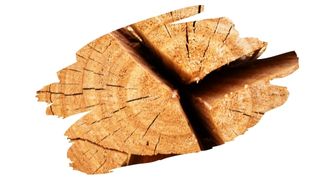Is that wood turned log already beginning to show cracks and fine splits? This is a problem that often crops up when you work with ‘green’ wood.
Green wood refers to any type of freshly logged timber that hasn’t had time to season and dry out. So, there’s still plenty of moisture saturating the fibers of this newly logged timber.
On one hand, green wood is more pliable and easier to work with. But, on the other hand, it is much more likely to shift, shrink, and splinter as the moisture in it evaporates.
And when that happens, it can be enough to ruin your entire project. But can a coat of shellac wood finish be enough to prevent this from happening?
Well, in this post, you will quickly find out exactly what causes wood to crack — and why a straightforward milling process called ‘seasoning’ is the best way to prevent wood from splitting.
You will also discover the two easiest ways to prevent wood checks. And keep reading to learn if shellac can really stop wood from cracking.

This post may contain affiliate links to products that we receive a commission for (at no additional cost to you). Learn more here.
Why Does Wood Crack And Fracture As It Dries?
It’s mainly because of the moisture inside wood.
Freshly milled wood has a lot of water saturating it’s grain. Often referred to as the ‘moisture content’ of wood, freshly logged lumber (i.e. green wood) has a moisture content of nearly 100%.
Related Post: Can You Paint Green Wood? (Solved!)
Yet, all of that extra moisture can make wood very unstable — especially once it begins to evaporate.
So, before we get to work with wood, we have to let it dry out and season.
But, here’s the thing; as wood dries it’ll start to shrink.
If it shrinks too quickly — or worse still, unevenly — it will form cracks. And when those cracks appear, this is known as ‘wood checking’.
At this point, wood starts to become very brittle. And if those checks are left unchecked (pun intended!) that wooden board becomes much too flimsy to work with.
Got It…So How Do You Keep Wood From Cracking?
The only way to stop wooden boards from cracking is t slow down the evaporation speed of that moisture. And there are generally two (relatively) easy ways to do this;
1). Regulate Room Humidity Levels
This method involves regulating the water vapor floating around in the air. As long as you manage to maintain humidity levels at about 45% to 65%, you’ll slow down the pace of evaporation.
Having said that, managing humidity in any given space isn’t always a practical option. So that’s why your next (and likely) best option is to…
2). Apply A Sealing Topcoat
This method involves coating exposed wood grain with a waterproofing sealer. And using a polyurethane or urethane sealant, will act to stop moisture vapor from escaping too rapidly (or at all).
Applying a waterproof sealer, (specifically over any exposed end grain), will stop wood from drying unevenly.
Related Post: What To Do When Solid Wood Cabinet Doors Start Warping (Solved!)
For example, end grain sealers are perfect for minimizing the impact of cracks on wood turning logs. By covering over exposed end grain, you can stop a log from splitting at the worst possible moment.
What About Shellac? Will Shellac Prevent Wood From Splitting?
While not completely waterproof, a shellac finish topcoat would certainly help to slow down moisture evaporation. And that, in turn, will allow wood to dry out more evenly.
But shellac isn’t a great option for preventing wood cracks in green wood, for three key reasons:
Shellac Wood Finish Disadvantage No. 1: It’s Easily Water Damaged
Shellac is a wood finish that is easily damaged by water. And green wood has a lot of moisture in it.
So, coating this glossy wood finish directly onto green wood is going to cause ‘blushing’. Blushing is what we call the cloudiness that appears across a shellac finish whenever moisture gets into it.
Shellac Wood Finish Disadvantage No. 2: Waxed Shellac Is Difficult To Topcoat
Next-to-no other finish will stick onto a waxed shellac finish. This slippery substance is next to impossible to topcoat. However, waxed shellac’s dewaxed alternative is pretty much the complete opposite.
Related Post: Is Shellac A Good Finish For Outdoor Furniture?
So, short term, waxed shellac can prevent cracking. But later — after you’ve finished carving that log — that shellac coat will prove problematic. Especially if you decide you want to topcoat your wood craft with polyurethane.
Basically, don’t be surprised if a polyurethane topcoat peels off a waxed shellac covered item.
Shellac Wood Finish Disadvantage No. 3: Fillers Do Not Solve The Problem
Generally, when people think of using shellac to fix wood cracks, they use it as a kind of wood filler.
By melting a shellac filler stick, they pack shellac into an already-forming wood split. And then they hope that solves the problem.
But of course, doing that doesn’t solve the real problem — which is rapid evaporation.
Now, just to be clear, the shellac filler itself will be stable, but that fast-drying log won’t be.
So the end result? That wood crack will continue to split and destabilize around that hardened shellac resin.
To Wrap Up, Here Are The 3 Key Takeaways From This Post…
- 1). Wood cracks come about due to moisture evaporation. If wood dries out too unevenly, it can split as it shrinks.
- 2). If you want to stop wood from cracking like this, you need to slow down the rate of moisture evaporation. The simplest way to do this is to coat any exposed wood grain with a waterproofing sealant.
- 3). Shellac isn’t waterproof, but it is fairly water resistant. However, if you layer this finish onto exposed wood grain, it can prevent wood from drying out too quickly. But, if you use shellac to fill in a crack, it won’t be able to stabilize a log that’s still drying out.



